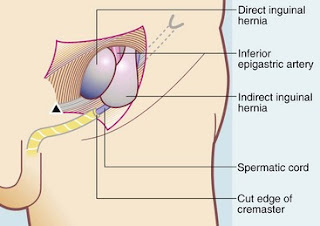HERNIA SYMPTOMS
A hernia may be a symptomatic or may be discovered incidentally
(asymptomatic)during a routine
physical examination.If noticed by
the patient, except for the
bulge, the usual
reducible hernia
produces no symptoms other than a dull pain. The
degree of pain
vary
from one individual to
another. This pain occurs when a
sudden
enlargement occurs and allows descent of a loop of small
gut
into the hernial sac.
The pain may then develop due to
pressure and is of a visceral origin.
With groin hernia, the location of the
mass should be helpful in
distinguishing the
femoral hernia. The clinical
distinction
between direct
and indirect hernia by physical
examination is
required scince.
The operative procedure for the repair of the
defects have to be different. A thumb placed over the internal
inguinal ring
should keep an indirect hernia reduced
when the
patient strains while permitting a
direct hernia to appear.
The
predominant finding with an incarcerated
or strangulated
hernia is a tender mass at one of the
hernial sites.
TREATMENT
The non-operative treatment of a
hernia involves the use of some
external device or turss to maintain hernial
reduction. In the
groin,
a truss is
ineffective in maintaining
satisfactory
reduction. A properly fitting corset may be an
exellent remedy,
however, for a ventral hernias,
particularly when a large defect
develops in an abdominal wound which becomes
infected following
laparotomy.
PRINCIPLES OF SURGICAL REPAIR
The essential steps to the repair of
hernias are:
1. The
separation and excision of
the peritoneal sac
after
reduction of its contents, and
2. The repair of the fascial defect
through which the hernia has
appeared
Any questions be sent to drmmkapur@gmail.com
All older posts are stored in archives for access and review.
Visitors that follow may post contributions tothe site,please write toaddress above.
To create consumer/provider engageet visit www.otmanagr.blogspot.com




